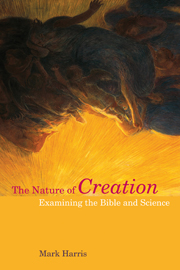Book contents
- Frontmatter
- Contents
- Preface
- Abbreviations
- 1 Introduction
- 2 Creation According to Modern Science
- 3 Creation According to the Bible I: Genesis
- 4 Creation According to the Bible II: The Creation Motif
- 5 The Framework of Biblical Cration
- 6 Creator–creation: How can a Ralationship be Described?
- 7 The Fall
- 8 Suffering and Evil
- 9 Scientific Eschatology and New Creation
- 10 Conclusions
- Bibliography
- Index of Ancient Citations
- Index
6 - Creator–creation: How can a Ralationship be Described?
- Frontmatter
- Contents
- Preface
- Abbreviations
- 1 Introduction
- 2 Creation According to Modern Science
- 3 Creation According to the Bible I: Genesis
- 4 Creation According to the Bible II: The Creation Motif
- 5 The Framework of Biblical Cration
- 6 Creator–creation: How can a Ralationship be Described?
- 7 The Fall
- 8 Suffering and Evil
- 9 Scientific Eschatology and New Creation
- 10 Conclusions
- Bibliography
- Index of Ancient Citations
- Index
Summary
CREATION FROM NOTHING (CREATIO EX NIHILO)
The scientific revolutions of the last 150 years have had far-reaching implications for how we view God's relationship with the world. The emphasis upon evolutionary models in both physics and biology has led to a re-appreciation of the biblical perspective which puts God's intimate presence with the world alongside God's above-and-beyond transcendence.
In this chapter we will look at the theological framework of the biblical creation material in the light of modern science. We will do this by assessing two categories which have been widely used to distinguish different types of God's creative work – creatio ex nihilo (“creation from nothing”) and creatio continua (“continuous creation”). These categories are often used in the science-theology field, but they are of uncertain status in biblical ideas of creation, as we shall see. Nevertheless, I will point out that they introduce important considerations for the models of God's relationship with the world which we see in the Bible. In other words, although the categories were constructed hundreds of years later than the biblical creation texts first came into written form, yet they introduce a useful way of reading the biblical texts theologically and in conjunction with scientific interpretations.
Information
- Type
- Chapter
- Information
- The Nature of CreationExamining the Bible and Science, pp. 111 - 130Publisher: Acumen PublishingPrint publication year: 2013
